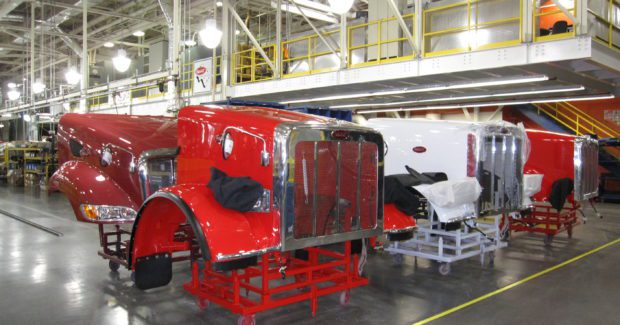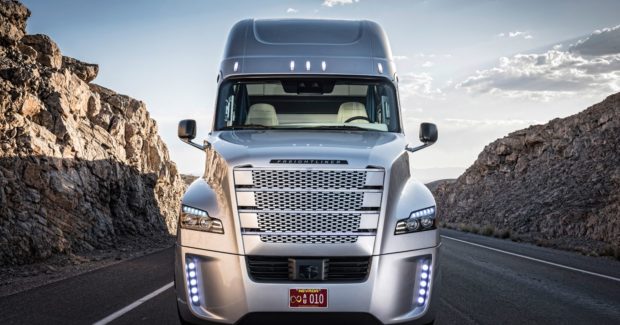Keep On Truckin’: On the Move in Heavy-Haul Transportation
Growing demand for freight transportation offers great business opportunities for fabricators that supply parts and assemblies to the heavy-haul trucking industry.
Posted: December 13, 2017
“Move it, move it, move it!” once triggered memories of Sergeant Carter yelling at Gomer Pyle in an old television comedy about the Marines, but now it’s the serious credo of heavy-haul truckers that moved around 10.73 billion tons of freight in 2017 and are on the road to becoming a trillion dollar industry by 2024. According to the American Trucking Association (Arlington, VA), total motor carrier revenue should grow 5.4 percent annually until 2023, then slow to 4.7 percent through 2028, when it reaches $1.24 trillion. “As the U.S. population grows and the economy increases with it, we will see continued gains in demand for freight transportation,” says Bob Costello, the chief economist for ATA. Wherever you travel, count on seeing even more long-haul trucks on the road as sales of Class 8 vehicles increase by 38 percent, from 186,003 units last year to 257,567 in 2028. The overall number of Class 8 trucks in operation will increase 19 percent, from 3.43 million now to 4.07 million by 2028.1
Class 8 heavy-duty vehicles include tractor-trailers and single-unit dump trucks with a gross vehicle weight rating of 33,000 lb or more. These trucks typically have three or more axles. A standard 5-axle tractor-trailer combination uses trailers that vary in length from 8 ft containers up to 57 ft van trailers, with the most common length being a 53 ft trailer. Specialized trailers for oversized loads can be considerably longer. A Class 8 tractor-trailer can have a legal gross combined weight of 80,000 lb or more on interstate highways, but “only 10-12 percent of these vehicles will reach that allowable limit,” notes Andrew Halonen, the president of Mayflower Consulting, LLC (Calumet, MI) and author of “Lightweight Materials for Heavy Trucks” in OEM Off-Highway (Fort Atkinson, WI). “These are the carriers that are motivated to reduce weight and are early adopters of new technologies to accomplish it. The most stringent are the bulk haulers who often reach the maximum weight before their tank is full. Behind them are those that carry refrigerated freight and others that move glass, metals and lumber.” 2
THE LIGHTWEIGHTING DIET
With demand booming for carriers in the face of tougher fuel economy expectations, manufacturers heed the mantra of ‘lighter structure, greater load’ with high-strength materials that reduce weight but maintain payload capabilities. For example, exterior cabs are typically made of aluminum, steel, plastic or sheet mold composite, but aluminum continues to remain a material of choice. “About 60 percent of exterior cabs use aluminum,” states Halonen. “Aluminum was originally preferred for corrosion resistance, but now aluminum bodies are desired for weight reduction.” Aluminum is now used in side sills, A-pillars, B-pillars, roof rails, sill plates, seat structures, sunroof components, control arms, motor mounts, blocks for ABS systems and a variety of body and closure components. Many bumper beams are now made with 6082 aluminum alloy that has the formability and ductility necessary to fabricate the desired shapes yet still meet crash energy management requirements for the applications.3
In the drive to lose weight, wheels are being reinvented. “Converting 22 in wheels from steel to aluminum saves about 77 lb on the steer axle and 115 lb on each tandem, a total of 307 lb per tractor,” explains Halonen. “Inside the wheel is a hub made of ductile iron, austempered ductile iron (ADI) or A356 aluminum made in a permanent mold casting process. One major axle producer said that aluminum hubs are now standard on OEM tractors and save about 150 lb from iron hubs. A forged aluminum fifth wheel saves another 100 lb in weight. For larger wheels or higher axle and fatigue loads, there are much stronger aluminum alloys than A356 for the hub application.” 2
In other weight-loss applications, improvements in roll forming and the ability to selectively increase the section size have rekindled thinking about a possible aluminum or 140,000 psi steel high-strength steel frame that could shed another to 200-300 lb off heavy trucks. “Alcoa and Metalsa demonstrated an aluminum-intensive frame assembly that incorporates rails along with suspension mounts and cross members,” says Halonen. “They report a potential savings of 1,000 lb over a traditional steel frame assembly.” Polymer-based materials are now used for aerodynamic fairings over the front bumper, fuel tanks and roof; for aerodynamic skirts under the trailers; and for covering the wheels. “Using injection-molded plastics or reinforced plastics is a great choice for these non-structural applications because they are considerably lighter and lower cost than aluminum,” adds Halonen.2
References
- “Trucking to be a Trillion-Dollar Industry by 2024,” Truckerplanet, July 24, 2017. Retrieved from truckerplanet.net.
- “Lightweight Materials for Heavy Trucks,” Andrew Halonen, OEM Off-Highway, January 28, 2016. Retrieved from www.oemoffhighway.com.
- “What Heavy-Duty Truck Manufacturers Know About Aluminum,” Gary S. Vasilash, Automotive Design & Production, August 1, 2016. Retrieved from www.adandp.media.
Fabricators that supply parts and assemblies to the heavy-haul trucking industry see all of these trends as big opportunities to grow their business, but competition can be brutal. To help them stay competitive on job bidding, here is some of the latest fabrication equipment that can save them more time and labor as they process new and expensive materials to make complex parts quicker and more accurately:
Multi-Mode Feed Capability Increases Coil-Fed Laser Blanking Speeds
With Continuous Mode (On the Fly Cutting) capabilities on coil-fed laser blanking systems from LaserCoil Technologies, users can choose either Feed Index Mode (Stop/Start) or Continuous Mode for the best production run rate and reliability.
Powerful, Flexible Fiber Laser Cutting for Trailer Body Manufacturers
Using HighSpeed Eco cutting technology with a newly designed bi-flow nozzle that minimizes nitrogen consumption while maximizing productivity, the TruLaser 5030 fiber laser from TRUMPF can process complex contours and power through mild steel up to 1 in, stainless steel up to 1.5 in and aluminum up to 1 in.
High Precision Coil Processing Lines for Fineblanking Brake System Components and More
The Fineblanking Edition HD straightener in high precision coil processing lines from COE Press Equipment addresses coil set and crossbow issues necessary to achieve the flatness required for producing near net shape blanked parts.
Ultra-High Speed Fiber Laser Cutting for Trailer Body Manufacturers
The Electra FL 3015 8 kW fiber laser cutting machine from LVD Strippit maintains 2G acceleration while cutting to produce high quality, high accuracy cuts in simple to complex configurations on ferrous and non-ferrous materials.
Highly Efficient 3D Laser Cutting of Chassis and Complex Vehicle Body Parts
The virtually wear-free JENOPTIK-VOTAN BIM 4 kW laser cutting machine from JENOPTIK can cut a circle or other standard contour in just one second, with repeat accuracy up to 50 μm in optimal conditions.
Economical Fiber Laser Cutting of Ferrous and Non-Ferrous Materials
The compact LS3015GC fiber laser cutting system from Murata Machinery uses an integrated flying optics system with internal controls that monitor laser output, laser beam and light reflection for superior cutting of ferrous and non-ferrous materials, including steel, stainless steel, aluminum, brass and bronze.
Plasma Beveling Gets Smart
The DMX Automated Plasma Beveller from ESAB cuts the full range of weld preparations, including V, Y, X, and K bevels, with cut angles up to 45 deg on materials up to 50 mm.
High Speed, High Precision Bending
The servo-hydraulic Xpert 150 press brake from Bystronic can reduce bending cycle times up to 35 percent by reaching 600 ipm approach speeds and 47 ipm bending speeds without sacrificing accuracy.
Lasting Protection Against Rust and Corrosion for Trucks and Trailers
CHEMLINE 7025 polyurea hybrid coating from Chemline protects trucks and trailers against rust and corrosion due to weather, de-icing chemicals, and other adverse conditions, and provides an exceptional impact and abrasion-resistant barrier against scratches from gravel and dents from hauling animals or heavy equipment.











